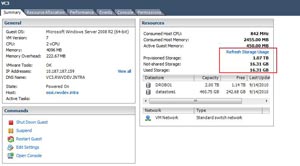Religious Issue #6: Thin Provisioning
Within virtualization circles, there is debate about whether or not to use thin provisioning on the hypervisor. Thin provisioning is available on all major hypervisors, including VMware's vSphere 4. For vSphere, thin provisioning of a virtual machine disk file (VMDK) incrementally grows the disk as the guest operating system increases its storage requirement.
Thin provisioning with vSphere has a number of caveats. First, there is no incremental shrink. This means if that the guest operating system incurs a growth of 1 GB, and then that space is removed from the guest; the 1 GB is still consumed within the VMDK. The solution is a Storage vMotion activity which will resize the destination VMDK to the actual consumption on disk. Storage consumption usually only goes up; so this behavior isn't exactly too much of an inconvenience in the everyday administrator's storage management practice.
The good news is that if the guest virtual machine consumes an additional 1 GB of storage in the above example and then is removed and subsequently replaced by another 1 GB of growth on the guest operating system's file system, the net growth is only 1 GB. Guest virtual machine behavior may dictate otherwise, but this is a generalization. You can check the used vs. provisioned storage amounts for a vSphere virtual machine in the summary section of the vSphere Client (see Fig. 1).
 |
|
Figure 1. The provisioned amount compared to consumed amount for a thin provisioned disk on a virtual machine will show the usage at that moment. (Click image to view larger version.) |
The potential downside to a thin provisioned VMDK is the behavior associated with the guest virtual machine and the frequency of metadata updates. On a VMFS volume, a metadata update is a coordinated transaction across all hosts and paths connected to the datastore. This is probably the one downside of the VMFS architecture as there is not software coordinator node or management layer as other clustered file systems have in place. When the VMDK file grows in its thin provisioned state, a metadata update occurs for each growth operation. Aside from growing a virtual machine, the following activities constitute metadata updates, according to VMware KB 1005009:
- Creating a VMFS datastore
- Expanding a VMFS datastore onto additional extents
- Powering on a virtual machine
- Acquiring a lock on a file
- Creating or deleting a file
- Creating a template
- Deploying a virtual machine from a template
- Creating a new virtual machine
- Migrating a virtual machine with VMotion
- Growing a file, for example, a Snapshot file or a thin provisioned Virtual Disk
Generally speaking, metadata updates are something that you want to avoid and are probably the biggest ding against thin provisioned VMDKs. If you have good insight into the application's growth behavior, you may not want to thin provision those frequently growing virtual machines. Of course, you could rely on the storage system to do the thin provisioning and avoid the metadata updates.
How do you approach thin provisioning for vSphere virtual machines? Share your comments here.
Posted by Rick Vanover on 09/21/2010 at 12:48 PM